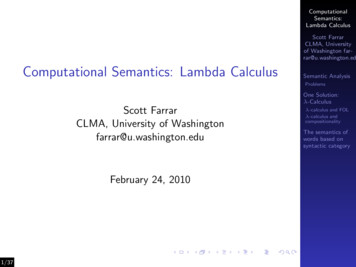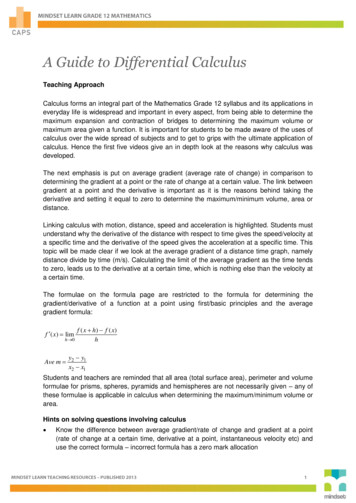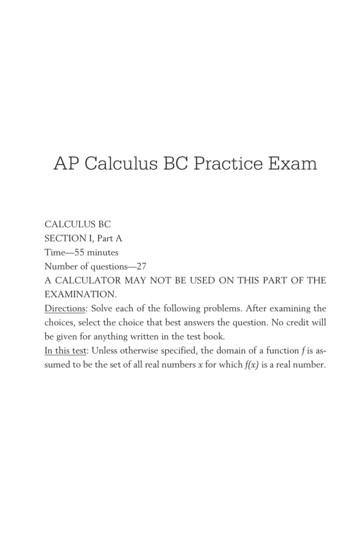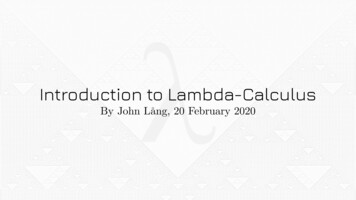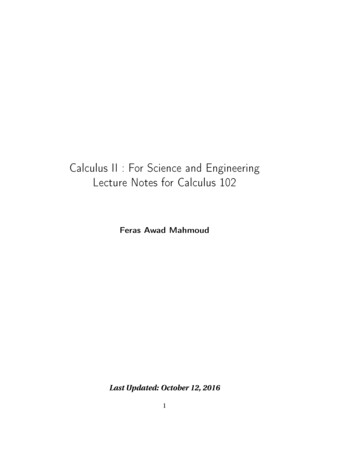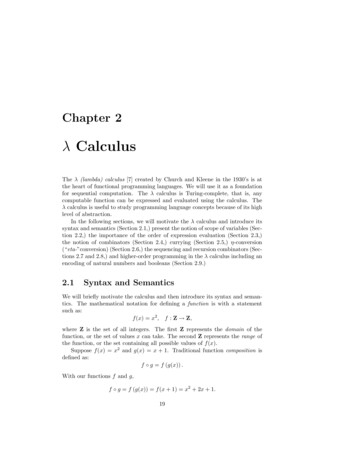
Transcription
Chapter 2λ CalculusThe λ (lambda) calculus [7] created by Church and Kleene in the 1930’s is atthe heart of functional programming languages. We will use it as a foundationfor sequential computation. The λ calculus is Turing-complete, that is, anycomputable function can be expressed and evaluated using the calculus. Theλ calculus is useful to study programming language concepts because of its highlevel of abstraction.In the following sections, we will motivate the λ calculus and introduce itssyntax and semantics (Section 2.1,) present the notion of scope of variables (Section 2.2,) the importance of the order of expression evaluation (Section 2.3,)the notion of combinators (Section 2.4,) currying (Section 2.5,) η-conversion(“eta-”conversion) (Section 2.6,) the sequencing and recursion combinators (Sections 2.7 and 2.8,) and higher-order programming in the λ calculus including anencoding of natural numbers and booleans (Section 2.9.)2.1Syntax and SemanticsWe will briefly motivate the calculus and then introduce its syntax and semantics. The mathematical notation for defining a function is with a statementsuch as:f (x) x2 , f : Z Z,where Z is the set of all integers. The first Z represents the domain of thefunction, or the set of values x can take. The second Z represents the range ofthe function, or the set containing all possible values of f (x).Suppose f (x) x2 and g(x) x 1. Traditional function composition isdefined as:f g f (g(x)) .With our functions f and g,f g f (g(x)) f (x 1) x2 2x 1.19
20CHAPTER 2. λ CALCULUSSimilarly,g f g (f (x)) g(x2 ) x2 1.Therefore, function composition is not commutative.In the λ calculus, we can use a different notation to represent the sameconcepts. To define a function f (x) x2 , we instead may write1 :λx.x2 .Similarly for g(x) x 1 we write:λx.x 1.To describe a function application such as f (2) 4, we write(λx.x2 2) 22 4.The syntax for λ calculus expressions ise :: v– variable λv.e– functional abstraction (e e) – function applicationThe semantics of the λ calculus, or the way of evaluating or simplifyingexpressions, is defined by the rule:(λx.E M ) E{M/x}.The new expression E{M/x} can be read as “replace ‘free’ x’s in E with M ”.Informally, a “free” x is an x that is not nested inside another lambda expression.We will cover free and bound variable occurrences in detail in Section 2.2.For example, in the expression:(λx.x2 2),E x2 and M 2. To evaluate the expression, we replace x’s in E with M ,to obtain:(λx.x2 2) 22 4.In the λ calculus, all functions may only have one variable. Functions withmore than one variable may be expressed as a function of one variable throughcurrying. Suppose we have a function of two variables expressed in the standardmathematical way:h(x, y) x y,h : (Z Z) Z.With currying, we can input one variable at a time into separate functions. Thefirst function will take the first argument, x, and return a function that will take1 Being precise, the λ calculus does not directly support number constants (such as ’1’) orprimitive operations (such as ’ ’ or x2 ) but these can be encoded as we shall see in Section 2.9.We use this notation here for pedagogical purposes only.
2.1. SYNTAX AND SEMANTICS21the second variable, y, and will in turn provide the desired output. To createthe same function with currying, let:f : Z (Z Z)and:gx : Z Z.That is, f maps every integer x to a function gx , which maps integers to integers.The function f (x) returns a function gx that provides the appropriate resultwhen supplied with y. For example,f (2) g2 , where g2 (y) 2 y.So:f (2)(3) g2 (3) 2 3 5.In the λ calculus, this function would be described with currying by:λx.λy.x y.To evaluate the function, we nest two function application expressions:((λx.λy.x y 2) 3).We may then simplify this expression using the semantic rule, also called βreduction (“beta”-reduction,) as follows:((λx.λy.x y 2) 3) (λy.2 y 3) 2 3 5.The composition operation can itself be considered a function, also calleda higher-order function, that takes two other functions as its input and returnsa function as its output; that is if the first function is of type Z Z and thesecond function is also of type Z Z, then: : (Z Z) (Z Z) (Z Z).We can also define function composition in the λ calculus. Suppose we wantto compose the square function and the increment function, defined as:λx.x2 and λx.x 1.We can define function composition as a function itself with currying as follows:λf.λg.λx.(f (g x)).Applying two variables to the composition function with currying works thesame way as before, except now our variables are functions:((λf.λg.λx.(f (g x)) λx.x2 ) λx.x 1) (λg.λx.(λx.x2 (g x)) λx.x 1) λx.(λx.x2 (λx.x 1 x)).
22CHAPTER 2. λ CALCULUSThe resulting function gives the same results as f (g(x)) (x 1)2 .In the Scheme programming language we can use λ calculus expressions.They are defined using a similar syntax. To define a function we use the code:(lambda([x y z .])expr)where variables x, y, z, etc. are optional. Scheme syntax allows you to havefunctions of zero variables, one variable, or more than one variable. The code:(lambda(x) (* x x))describes the square function. Note that even common operations are consideredfunctions and are always used in a prefix format. You may define variables(which may themselves be functions) with:(define a b).For example,(define f (lambda(x) (* x x)))defines a function f (x) x2 . To perform a procedure call, use the code:(f [x y z .])where x, y, z, etc. are additional parameters that f may require. The code:(f 2)evaluates f (2) 4.2.2Free and Bound Variables in the λ CalculusThe process of simplifying (or β-reducing) in the λ calculus requires furtherclarification. The general rule is to find an expression of the form(λx.E M ),called a redex (for reducible expression,) and replace the “free” x’s in E withM ’s. A free variable is one that is not bound by a lambda expression representinga functional abstraction. The functional abstraction syntax, λv.e, defines thescope of the variable v to be e, and effectively binds occurrences of v in e. Forexample, in the expression(λx.x2 x 1)the second x is bound by the λx, because it is part of the expression definingthat function, i.e., the function f (x) x2 . The final x, however, is not boundby any function definition, so it is said to be free. Do not be confused by the factthat the variables have the same name. The two occurrences of the variable xare in different scopes, and therefore they are totally independent of each other.An equivalent C program could look like this:
2.2. FREE AND BOUND VARIABLES IN THE λ CALCULUS23int f(int x) {return x*x;}int main() {int x;.x x 1;return f(x);}In this example, we could substitute y (or any other variable name) for all xoccurrences in function f without changing the output of the program. In thesame way, the lambda expression(λx.x2 x 1)is equivalent to the expression(λy.y 2 x 1).We cannot replace the final x, since it is unbound, or free. To simplify theexpression(λx.(λx.x2 x 1) 2)You could let E (λx.x2 x 1) and M 2. The only free x in E is the finaloccurrence so the correct reduction is(λx.x2 2 1).The x in x2 is bound, so it is not replaced.However, things get more complicated. It is possible when performing βreduction to inadvertently change a free variable into a bound variable, whichchanges the meaning of the expression. In the statement(λx.λy.(x y) (y w)),the second y is bound to λy whereas the final y is free. Taking E λy.(x y)and M (y w), we could mistakenly arrive at the simplified expressionλy.((y w) y).But now both the second and third occurrences of y are bound, because they areboth a part of the functional abstraction starting by λy. This is wrong becauseone of the y occurrences should remain free as it was in the original expression.To solve this problem, we can change the λy expression to a λz expression:(λx.λz.(x z) (y w)),
24CHAPTER 2. λ CALCULUSwhich again does not change the meaning of the expression. This process iscalled α-renaming (“alpha”-renaming.) Now when we perform the β-reduction,the original two y variable occurrences are not confused. The result is:λz.((y w) z)where the free y remains free.2.3Order of EvaluationThere are different ways to evaluate λ calculus expressions. The first methodis to always fully evaluate the arguments of a function before evaluating thefunction itself. This order is called applicative order. In the expression:(λx.x2 (λx.x 1 2)),the argument (λx.x 1 2) should be simplified first. The result is: (λx.x2 2 1) (λx.x2 3) 32 9.Another method is to evaluate the left-most redex first. Recall that a redex isan expression of the form (λx.E M ), on which β-reduction can be performed.This order is called normal order. The same expression would be reduced fromthe outside in, with E x2 and M (λx.x 1 2). In this case the result is: (λx.x 1 2)2 (2 1)2 9.As you can see, both orders produced the same result. But is this alwaysthe case? It turns out that the answer is a qualified yes: only if both orders ofexpression evaluation terminate. Otherwise, the answer is no for expressionswhose evaluation does not terminate. Consider the expression:(λx.(x x) λx.(x x)).It is easy to see that reducing this expression gives the same expression back,creating an infinite loop. If we consider the expanded expression:(λx.y (λx.(x x) λx.(x x))),we find that the two evaluation orders are not equivalent. Using applicativeorder, the (λx.(x x) λx.(x x)) expression must be evaluated first, butthis process never terminates. If we use normal order, however, we evaluate theentire expression first, with E y and M (λx.(x x) λx.(x x)). Sincethere are no x’s in E to replace, the result is simply y. It turns out that it is onlyin these particular non-terminating cases that the two orders may give differentresults. The Church-Rosser theorem (also called the confluence property or thediamond property) states that if a λ calculus expression can be evaluated in twodifferent ways and both ways terminate, both ways will yield the same result.Also, if there is a way for an expression to terminate, using normal orderwill cause the termination. In other words, normal order is the best if you wantto avoid infinite loops. Take as another example the C program:
252.4. COMBINATORSint loop() {return loop();}int f(int x, int y) {return x;}int main() {return f(3, loop());}In this case, using applicative order will cause the program to hang, because thesecond argument loop() will be evaluated. Using normal order will terminatebecause the unneeded y variable will never be evaluated.Though normal order is better in this respect, applicative order is the oneused by most programming languages. Why? Consider the function f (x) x x. To find f (4/2) using normal order, we hold off on evaluating the argumentuntil after placing the argument in the function, so it yieldsf (4/2) 4/2 4/2 2 2 4,and the division needs to be done twice. If we use applicative order, we getf (4/2) f (2) 2 2 4,which only requires one division.Since applicative order avoids repetitive computations, it is the preferredmethod of evaluation in most programming languages, where short executiontime is critical. Some functional programming languages, such as Haskell, usecall-by-need evaluation, which will avoid performing unneeded computations(such as loop() above) yet will memoize the values of needed arguments (suchas 4/2 above) so that repetitive computations are avoided. This lazy evaluationmechanism is typically implemented with thunks, or zero-argument functionsthat freeze the evaluation of an argument until it is actually used, and futuresor references to these thunks that trigger the thawing of the expression whenevaluated, and keep its value for further immediate access.2.4CombinatorsAny λ calculus expression with no free variables is called a combinator. Becausethe meaning of a lambda expression is dependent only on the bindings of itsfree variables, combinators always have the same meaning independently of thecontext in which they are used.There are certain combinators that are very useful in the λ calculus:The identity combinator is defined as:I λx.x.
26CHAPTER 2. λ CALCULUSIt simply returns whatever is given to it. For example:(I 5) (λx.x 5) 5.The identity combinator in Oz2 can be written:declare I fun { X} X endContrast it to, for example, a Circumference function:declare Circumference fun { Radius} 2*PI*Radius endThe semantics of the Circumference function depends on the definitions ofPI and *. The Circumference function is, therefore, not a combinator.The application combinator is:App λf.λx.(f x),and allows you to evaluate a function with an argument. For example((App λx.x2 ) 3) ((λf.λx.(f x) λx.x2 ) 3) (λx.(λx.x2 x) 3) (λx.x2 3) 9.We will see more combinators in the following sections.2.5CurryingThe currying higher-order function takes a function and returns a curried version of the function. For example, it would take as input the Plus function,which has the typePlus : (Z Z) Z.The type of a function defines what kinds of values the function can receive andwhat kinds of values it produces as output. In this case Plus takes two integers(Z Z,) and returns an integer (Z.)The definition of Plus in Oz isdeclare Plus fun { X Y}X Yend2 We use examples in different programming languages (Scheme, C, Oz) to illustrate that theconcepts in the λ calculus are ubiquituous and apply to many different sequential programminglanguages.
272.6. η-CONVERSIONThe currying combinator would then return the curried version of Plus,called PlusC, which has the typePlusC : Z (Z Z).Here, PlusC takes one integer as input and returns a function from the integersto the integers (Z Z.) The definition of PlusC in Oz is:declare PlusC fun { X}fun { Y}X YendendThe Oz version of the currying combinator, which we will call Curry, wouldwork as follows:{Curry Plus} PlusC.Using the input and output types above, the type of the Curry function isCurry : (Z Z Z) (Z (Z Z)).So the Curry function should take as input an uncurried function and return acurried function. In Oz, we can write Curry as follows:declare Curry fun { F}fun { X}fun { Y}{F X Y}endendend2.6η-ConversionConsider the expression(λx.(λx.x2 x) y).Using β-reduction, we can take E (λx.x2 x) and M y. In the reductionwe only replace the one x that is free in E to getβ (λx.x2 y).βWe use the symbol to show that we are performing β-reduction on the exαpression (As another example we may write λx.x2 λy.y 2 since α-renaming istaking place.)
28CHAPTER 2. λ CALCULUSAnother type of operation possible on λ calculus expressions is called ηconversion (“eta”-reduction when applied from left to right.) We perform ηreduction using the ruleηλx.(E x) E.η-reduction can only be applied if x does not appear free in E.Consider the expression, λx.(λx.x2x), we can perform η-reduction toobtainηλx.(λx.x2 x) λx.x2 .We can also apply η-reduction to sub-expressions, i.e., starting with thesame expression as before, (λx.(λx.x2 x) y), we can perform η-reduction toobtainη(λx.(λx.x2 x) y) (λx.x2 y),which gives the same result as β-reduction.Another example of η-reduction follows:ηλx.(y x) y.η-reduction can be considered a program optimization. For example, consider the following Oz definitions:declare Increment fun { X} X 1 enddeclare Inc fun { X} {Increment X} endUsing η-reduction, we could statically reduce {Inc 6} to {Increment 6}avoiding one extra function call (or β reduction step) at run-time. This compileroptimization is also called inlining.η-conversion can also affect termination of expressions in applicative orderexpression evaluation. For example, the Y reduction combinator has a terminating applicative order form that can be derived from the normal order combinatorform by using η-conversion (see Section 2.8.)2.7Sequencing CombinatorThe normal order sequencing combinator is:Seq λx.λy.(λz.y x)where z is chosen so that it does not appear free in y.This combinator guarantees that x is evaluated before y, which is importantin programs with side-effects. Assuming we had a “display” function sendingoutput to the console, an example is((Seq (display “hello”)) (display “world”))
292.8. RECURSION COMBINATORThe combinator would not work in applicative order (call by value) evaluation because evaluating the display functions before getting them passedto the Seq function would defeat the purpose of the combinator: to sequenceexecution. In particular, if the arguments are evaluated right to left, executionwould not be as expected.The applicative-order sequencing combinator can be written as follows:ASeq λx.λy.(y x)where y is a lambda abstraction that wraps the original last expression toevaluate.The same example above would be written as follows:((ASeq (display “hello”)) λx.(display “world”))with x fresh, that is, not appearing free in the second expression.This strategy of wrapping a λ calculus expression to make it a value anddelay its evaluation is very useful. It enables to simulate call by name parameterpassing in languages using call by value. The process of wrapping is also calledfreezing an expression, and the resulting frozen expression is called a thunk.Evaluating a thunk to get back the original expression is also called thawing.2.8Recursion CombinatorThe recursion combinator allows defining recursive computations in the λ calculus. For example, suppose we want to implement a recursive version of thefactorial function:!1 if n 0f (n) n! .n(n 1)! if n 0We could start by attempting to write the recursive function f in the λ calculus (assuming it has been extended with conditionals, and numbers) as follows3 :f λn.(if( n 0)1( n (f ( n 1)))).The problem is that this function definition uses a free variable f , which isthe very factorial function that we are trying to define. To avoid this circulardefinition, we can extend the definition with another functional abstraction(lambda expression) to take the factorial function as follows:f λg.λn.(if( n 0)1( n (g ( n 1)))).3 We will use prefix notation for mathematical expressions to be more consistent withfunction application syntax in the λ calculus as introduced in Section 2.1
30CHAPTER 2. λ CALCULUSBefore we can input an integer to the function, we must input a function tosatisfy g so that the returned function computes the desired factorial value. Letus call this function X. Looking within the function, we see that the functionX must take an integer and return an integer, that is, X’s type is Z Z. Thefunction f will return the proper recursive function with the type Z Z, butonly when supplied with the correct function X. Knowing the input and outputtypes of f , we can write the type of f asf : (Z Z) (Z Z).What we need is a function X that, when we apply f to it, it returns the correctrecursive factorial function, that is, (f X) λn.(if( n0)1( n(X( n1)))) X,and so we need to solve the fixed point X of the function f , i.e., the solution tothe equation (f X) X.We could try applying f to itself, i.e.,(f f ).This does not work, because f expects something of type Z Z, but it is takinganother f , which has the more complex type (Z Z) (Z Z). A functionthat has the correct input type is the identity combinator, λx.x. Applying theidentity function, we get:(f I) λn.(if( n 0)1( n (I ( n 1)))) λn.(if ( n 0)1( n ( n 1))),which is equivalent tof (n) !1 if n 0.n (n 1) if n 0We need to find the correct expression X such that when f is applied to X,we get X, the recursive factorial function. It turns out that the X that worksis:X ( λx.(λg.λn.(if ( n 0) 1 (n (g ( n 1)))) λy.((x x) y))λx.(λg.λn.(if ( n 0) 1 (n (g ( n 1)))) λy.((x x) y))).Note that this λ calculus expression has a structure similar to the nonterminating expression:(λx.(x x) λx.(x x)),and explains why the recursive function can keep going.
312.9. HIGHER-ORDER PROGRAMMINGX can be defined as (Yf ) where Y is the recursion combinator,(f X) (f (Yf )) (Yf ) X.The recursion combinator that works for applicative evaluation order is defined as:Y λf.( λx.(f λy.((x x) y))λx.(f λy.((x x) y))).The normal order evaluation version of the recursion combinator is:Y λf.( λx.(f (x x))λx.(f (x x))).How do we get from the normal order evaluation recursion combinator to theapplicative order evaluation recursion combinator? We use η-expansion (thatis, η-conversion from right to left.) This is an example where η-conversion canhave an impact on the termination of an expression.2.9Higher-Order ProgrammingMost imperative programming languages, e.g., Java and C , do not allow usto treat functions or procedures as first-class entities, for example, we cannotcreate and return a new function that did not exist before. A function that canonly deal with primitive types (i.e., not other functions) is called a first-orderfunction. For example, Increment, whose type is Z Z, can only take integervalues and return integer values. Programming only with first-order functions,is called first-order programming.If a function can take another function as an argument, or if it returns afunction, it is called a higher-order function.For example, the Curry combinator, whose type is:Curry : (Z Z Z) (Z (Z Z)).is a higher-order (third order) function. It takes a function of type Z Z Zand returns a function of type Z (Z Z). That is, Curry takes a first-orderfunction and returns a second-order function. The ability to view functions asdata is called higher-order programming.42.9.1Currying as a higher-order functionHigher-order programming is a very powerful technique, as shown in the following Oz example. Consider an exponential function, Exp, as follows:4 The ability in some imperative programming languages to pass pointers to functions, asin a generic sort routine that can receive different element ordering functions, is only half ofthe equation. Truly higher-order programming requires the ability to create arbitrary newfunctions as done in the currying example in the text.
32CHAPTER 2. λ CALCULUSdeclare Exp fun { B N}if N 0 then1elseB * {Exp B N-1}endend.And recall the Curry combinator in Oz:declare Curry fun { F}fun { X}fun { Y}{F X Y}endendend.We can create a function to compute the powers of 2, TwoE, by just using:declare TwoE {{Curry Exp} 2}.To illustrate the execution of this expression, consider the following Oz computation steps (equivalent to two β-reduction steps in the λ calculus):TwoE {{Curry Exp} 2} {{fun { F}fun { X}fun { Y}{F X Y}endendend Exp} 2} {fun { X}fun { Y}{Exp X Y}endend 2} fun { Y}{Exp 2 Y}endIf we want to create a Square function, using Exp, we can create a reversecurry combinator, RCurry, as:declare RCurry
2.9. HIGHER-ORDER PROGRAMMING33fun { F}fun { X}fun { Y}{F Y X}endendend,where the arguments to the function are simply reversed.We can then define Square as:declare Square {{RCurry Exp} 2}.Higher-order programming enables us to view functions as data. Lisp is afunctional programming language that uses the same syntax for programs andfor data (lists.) This enables meta-circular interpretation: a full Lisp interpreter,written in Lisp, can be an input to itself.2.9.2Numbers in the λ CalculusThe λ calculus is a Turing-complete language, that is, any computable functioncan be expressed in the pure λ calculus. In many of the previous examples,however, we have used numbers and conditionals.Let us see one possible representation of numbers in the pure λ calculus: 0 λx.x 1 λx.λx.x. n 1 λx. n That is, zero is represented as the identity combinator. Each succesive number (n 1) is represented as a functional (or procedural) abstraction that takesany value and returns the representation of its predecessor (n.) You can thinkof zero as a first-order function, one as a second-order function, and so on.In Oz, this would be written:declare Zero Ideclare Succ fun { N}fun { X}NendendUsing this representation, the number 2, for example, would be the λ calculusexpression: λx.λx.λx.x, or equivalently in Oz:{Succ {Succ Zero}}
34CHAPTER 2. λ CALCULUS2.9.3Booleans in the λ CalculusNow, let us see one possible representation of booleans in the pure λ calculus: true λx.λy.x false λx.λy.y if λb.λt.λe.((b t) e)That is, true is represented as a function that takes two arguments and returns the first, while false is represented as a function that takes two argumentsand returns the second. if is a function that takes: a function b representing a boolean value (either true or false,) an argument t representing the then branch, and an argument e representing the else branch,and returns either t if b represents true, or e if b represents false.Let us see an example evaluation sequence for (((if true) 4) 5):(((λb.λt.λe.((b t) e) λx.λy.x) 4) 5)β ((λt.λe.((λx.λy.x t) e) 4) 5)β (λe.((λx.λy.x 4) e) 5)β ((λx.λy.x 4) 5)β (λy.4 5)β 4Note that this definition of booleans works properly in normal evaluationorder, but has problems in applicative evaluation order. The reason is that applicative order evaluates both the then and the else branches, which is a problemif used in recursive computations (where the evaluation may not terminate) orif used to guard improper operations (such as division by zero.) The applicativeorder evaluation versions of if, true, and false can wrap the then and elseexpressions inside functional abstractions, so that they are values and do notget prematurely evaluated, similarly to how the applicative order evaluation sequencing operator wrapped the expression to be evaluated last in the sequence(see Section 2.7.)In Oz, the following (uncurried) definitions can be used to test this representation:declare LambdaTrue fun { X Y}X
2.10. EXERCISES35enddeclare LambdaFalse fun { X Y}Yenddeclare LambdaIf fun { B T E}{B T E}end2.10Exercises1. α-convert the outer-most x to y in the following λ calculus expressions, ifpossible:(a) λx.(λx.x x)(b) λx.(λx.x y)2. β-reduce the following λ calculus expressions, if possible:(a) (λx.λy.(x y) (y w))(b) (λx.(x x) λx.(x x))3. Simulate the execution of Square in Oz, using the definition of RCurrygiven in Section 2.9.1.4. Using the number representation in Section 2.9.2, define functions Plus,PlusC (its curried version) in Oz, and test them using Mozart (Oz’s runtime system.)5. Write a function composition combinator in the λ calculus.6. Define a curried version of Compose in Oz, ComposeC, without using theCurry combinator. (Hint: It should look very similar to the λ calculusexpression from Exercise 5.)7. η-reduce the following λ calculus expressions, if possible:(a) λx.(λy.x x)(b) λx.(λy.y x)8. Use η-reduction to get from the applicative order Y combinator to thenormal order Y combinator.9. What would be the effect of applying the reverse currying combinator,RCurry, to the function composition combinator?
36CHAPTER 2. λ CALCULUSdeclare Compose fun { F G}fun { X}{F {G X}}endendGive an example of using the {RCurry Compose} function.10. Define a operation for the representation of numbers given in Section 2.9.2. Test your addition operation in Oz.11. Give an alternative representation of numbers in the λ calculus (Hint:Find out about Church numerals.) Test your representation using Oz.12. Give an alternative representation of booleans in the λ calculus (Hint:One possibility is to use λx.x for true and λx.λx.x for false. You needto figure out how to define if.) Test your representation using Oz.13. Create an alternative representation of booleans in the λ calculus so thatconditional execution works as expected in applicative evaluation order(Hint: Use the strategy of wrapping the then and else branches to turnthem into values and prevent their premature evaluation.) Test your representation using Oz.14. For a given function f , prove that (f (Yf )) (Yf ).
Chapter 2 λ Calculus The λ (lambda) calculus [7] created by Church and Kleene in the 1930's is at the heart of functional programming languages. We will use it as a foundation for sequential computation. The λ calculus is Turing-complete, that is, any computable function can be expressed and evaluated using the calculus.

